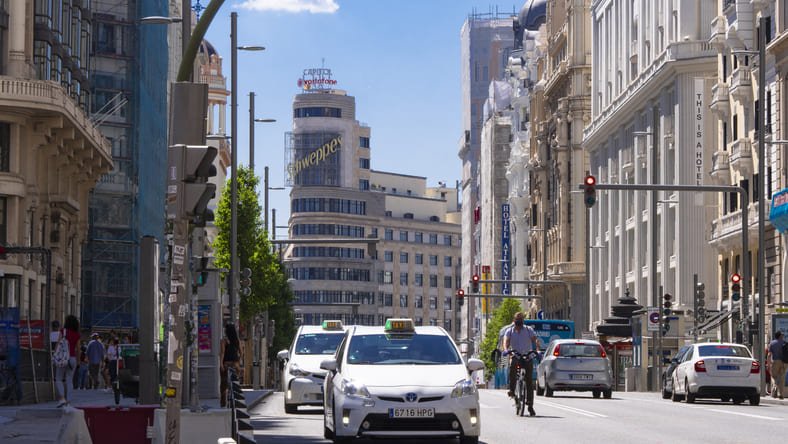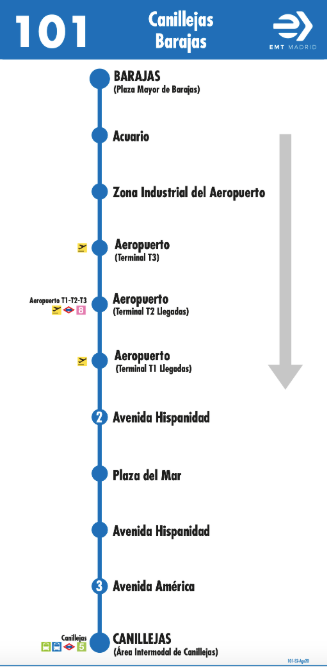
Are you planning to visit Madrid and wondering how to get to the city centre from Adolfo Suárez Madrid-Barajas airport, or how to get back to the airport at the end of your stay? It couldn’t be easier.
Adolfo Suárez Madrid-Barajas Airport is Madrid’s main airport, located around 12 kilometres north-east of the city centre. It is Spain’s largest airport and one of Europe’s main air hubs. Modern and well-equipped, it offers a host of services to travellers, including duty-free shops, restaurants, lounges and free Wi-Fi. The airport is made up of four terminals, each offering easy access to various means of transport. One of the things that has always surprised me is how easy it is to get around the airport. In Terminal 4, for example, arriving and departing passengers pass each other under the multi-coloured beams.

Whatever the time of day or night, there is always public transport in Madrid to take you to Madrid – Bajaras airport or to the centre of Madrid.
Here’s an overview of the different ways to get from Madrid airport to the city centre.
If you’re planning to visit Madrid for the festive season, explore our selection of the city’s best accommodation, carefully classified by district.
1. Taxis to the centre of Madrid
There is a taxi rank at each airport terminal.
- Journey time: Approximately 20-30 minutes to the city centre, depending on traffic.
- Fare: The fixed fare is €33 for journeys between the airport and the city centre. However, if you are travelling to the western suburbs of Madrid, i.e. away from the airport, the fare will be around €55.

Advantages: It’s the most practical and least tiring! Taxis are comfortable, fast and door-to-door. Once you have queued for your taxi, the taxi dispatcher will tell you which taxi is best for you, depending on the amount of luggage and the number of people in your party. To get to the centre of Madrid, the speed advantage of a taxi is not necessarily going to be obvious compared with the metro. But to get to the outskirts of Madrid, opting for a taxi seems to be the best plan in terms of ease and time saving.
Disadvantages: The cost, of course! The fare is fixed. If you want to take a taxi with young children, you will have to deal with the problem of car seats, which represent a significant additional cost. Émilie has been refused access to taxis several times because there are no car seats for children.
2. Private drivers to get you to the centre of Madrid
You can also opt for a transfer with a driver waiting for you directly at the exit door (with a small sign!).
- Journey time: Approximately 20-30 minutes to the city centre, depending on traffic.
- Fare: Varies according to demand and time of day, but generally similar to taxi fares.
- If necessary, you can reserve a car seat for your children. Fares start from €36.
Advantages: Ideal for groups and often more economical. The vehicles are very comfortable and the service is top quality. It’s also great if you don’t speak Spanish!
Disadvantages: Fares vary and you may need an internet connection to check your booking.
A tip from Vivre Madrid: To make it easier for you to discover Madrid and find information quickly on your phone, download our « Visiting Madrid in a few days » guide. It covers everything from the must-sees to outings, visits off the beaten track and not-to-be-missed rooftops. It also includes restaurant addresses, a selection of accommodation and practical information to help you organise your stay. And all with a downloadable map of Madrid listing all the information. In short, a great travel companion!
3. Airport/city centre bus transfer
City buses (EMT)
These are the blue buses that serve the whole city. Routes 200 and 101 run between the airport and the city centre. This is a very economical option for travellers.
- Timetable: Generally from 5am to 11.30pm.
- Journey time: Approximately 40-50 minutes to the city centre, depending on traffic.
- Fare: €1.50.
Advantages: The price, of course. It’s the cheapest option! The €3 tax that applies to your metro ticket does not apply in this case (I’ll tell you more about it below). You will have to buy your ticket from the driver. Take some coins with you to make things run more smoothly. If you don’t have any, you can pay directly with your credit card at the terminal inside the bus. If you have small children in pushchairs, unlike on the metro, you’ll have fewer gantries to go through and fewer steps to climb.
Disadvantages: When you take the bus, you always have doubts about the timetable, waiting times, etc. And it’s always a bit stressful to miss a stop!
But to remedy this :), here are the route details:
- L200: Madrid Airport <> Avenida de America (metro station, which is a major hub). You’ll find this bus at terminals T1, T2 and T3.

Find out more about the L200 route here.
- L101: Madrid Airport <> Canilleja. You will find this bus at terminals T1 and T2.

Find out more about the L101 route here.
If you then need to take the metro, you will need a ticket, unless you have a tourist ticket.
Good to know: the various terminals are linked by free shuttle buses.
The Express Bus
This is an excellent alternative for those who prefer a direct service with no connections. This bus runs between the airport and Atocha station, stopping at O’Donnell, Plaza de Cibeles and Plaza de Colón. This yellow shuttle is located at terminals T1, T2 and T4.
- Timetable: The service operates 24 hours a day, 7 days a week.
- Journey time: Approximately 40-50 minutes to the city centre, depending on traffic.
- Fare: €5/person, payment in cash or credit card on board the bus.
It runs day and night. At night, it runs slightly less frequently, approximately every 35 minutes. This shuttle is a fast, economical option for getting into the city centre, but the route does not offer many stops. If you want to go to an area that is not distributed, you will have to make a change and take the metro or another bus.
The bus route: Madrid-Barajas airport => the centre of Madrid (Cibeles) => Atocha intermodal station.

Find out more about the L101 route here.
To find out more about Madrid’s public transport system, read our full article on the subject.
4. Getting to Madrid city centre from Barajas airport by metro
The Madrid metro is one of the most convenient and economical options for getting to the city centre from the airport. Line 8 (pink) runs directly to the airport, with two stations: Aeropuerto T1-T2-T3 and Aeropuerto T4.
Good to know: to take the metro, you need to buy a travel card, which you can also use to take the bus. You can buy it at a terminal and pay a mandatory €3 tax per person in addition to the price of the metro ticket. Don’t panic, you can change the language on the terminal where you buy your metro card and follow the simple instructions.

- Timetable: The metro runs from 6.00 am to 1.30 am.
- Journey time: Approximately 15-20 minutes to Nuevos Ministerios station, in the heart of Madrid.
- Fares: Tickets cost around €5 (including a €3 airport supplement).
Benefits: The cost is low and the journey time does not vary according to traffic. If you don’t have a lot of luggage, this is the ideal solution.
Disadvantages: Depending on your arrival time, there may be a queue at the metro card purchase machines. As a family, the journey to the terminal where you take the metro. And once you get to your station, there may be steps or escalators to take with a pushchair (if there are no lifts).
5. Transfer from Madrid airport to the city centre by train (Cercanías)
To get from Madrid airport to the city centre, you can only take the train from Terminal 4. This is line C1. It will take you to Madrid’s main destinations: Chamartín, Nuevos Ministerios, Recoletos, Atocha and Príncipe Pío. This train is comfortable and economical, but less frequent than the metro. Limited service at night.
- Timetable: From 5am to 11.30pm.
- Journey time: Approximately 25 minutes to Atocha station.
- Fare: €2.60, you can combine with the metro afterwards.
Are you looking for a locker to store your luggage so that you can visit Madrid in peace and quiet? Take a look at Radical Storage’s services and choose the option that suits you best.
6. Car hire at Madrid airport
For those wishing to explore Madrid and the surrounding area at their own pace, car hire is an ideal option. Car hire companies are located at Terminals T1 and T4. You’ll find a wide range of rental companies, but I’d strongly advise you to avoid low-cost companies such as Goldcar, Rentacar and all the others you’ll find for €7/8 a day. They’ll add taxes and insurance, and in the end you could end up paying more. We speak from experience!
Advantages: If you’re going on a road-trip around Madrid during your stay, hiring a car is a good idea.
Disadvantages: The cost, because if you have to hire extra car seats, the bill quickly climbs. You’ll also need to allow a certain amount of extra time on arrival and when you return the car, especially if your rental company is located in an area away from the airport. You may also need to take a bus to hire the car… I wouldn’t recommend this option, as it’s quite inconvenient, especially with children (and the price difference isn’t necessarily much compared with hire companies located directly at the airport).
Let the holidays begin!
Whatever your budget or preferences, there are plenty of options for getting to Madrid city centre from the airport. The metro and Cercanías trains are ideal for those looking for speed and economy, while buses and taxis offer extra comfort and convenience. Think about your itinerary, your luggage and your timetable to choose the option best suited to your journey. Enjoy your stay in Madrid!
If you’re looking for a different experience, visit the Canary Islands. Discover our complete guide to the Canary Islands.
